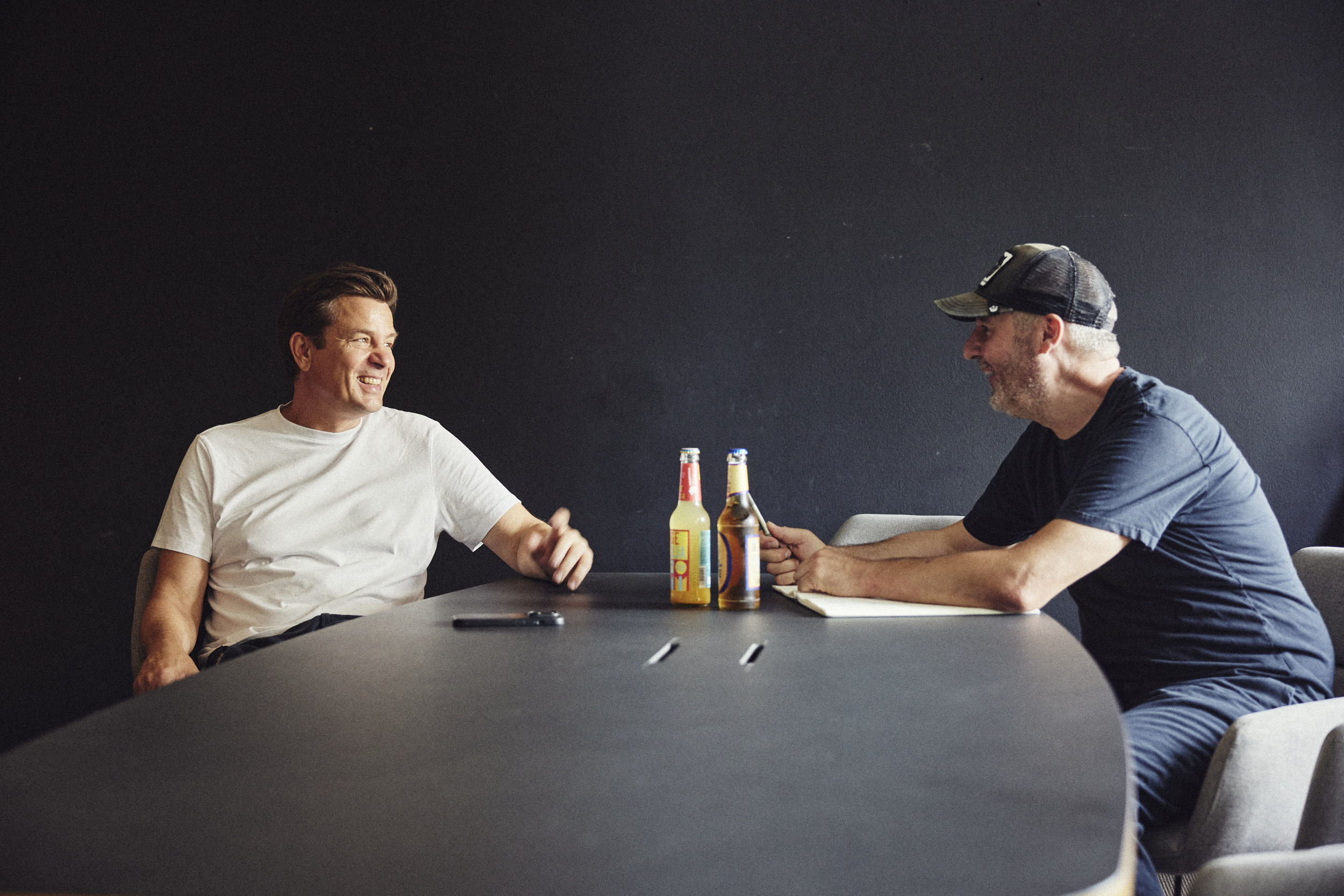SAY HI TO AI.
AN INTERVIEW WITH KLAUS SCHWAB.
Interview: 2030 / Paul Wagner
Photos: Leopold Fiala
In the black conference room of the House of Hype, Klaus Schwab from the strategy consultancy bemorrow is making himself comfortable with a croissant and coffee. I met Klaus at the German ad agency, die argonauten, where we jointly pitched for MTV’s digital account and had an amazing amount of fun. Klaus’s career path is impressive: As Managing Director, he was responsible for strategic services at die argonauten, later merged his own strategy consultancy comrepublic with the strategy giant diffferent, became the third partner in the management team there, founded a second strategy consultancy with bemorrow and was Co-CEO of the Plan.Net Group for Digital Communication, the largest digital agency in Germany, from 2016 to 2020. Today, Klaus and his bemorrow team advise companies on topics such as digital brand management, strategy development and transformation in a collaborative, participative and often brutally honest manner.

Klaus Schwab / Photo: Leopold Fiala
Klaus, a few years ago you wrote a highly acclaimed essay, which won an award for science communication, on the question: Can algorithms campaign? How do you feel about it today?
An incredible amount has changed since 2019. What interested me at the time was the extent to which AI could actually be creative. I discussed it with the creators of Birds on Mars in Berlin, a very exciting company that develops artificial intelligence products. Back then, they had created something that really impressed me, namely the Digital Muse. And they called it Inspirational AI. Florian Dohmann, co-founder of Birds on Mars, had developed a machine learning system called AIR for the artist Roman Lipski. It analysed Lipski’s pictures, deconstructed and then reassembled them. These new pictures gave Lipski inspiration for further hand-painted pictures. The result was a ping-pong of ideas and inspiration between artist and artificial intelligence. Lipski said at the time that his art had evolved more in one year with the Digital Muse than in the previous ten years. His art also inspired Google CEO Sundar Pichai when Birds on Mars presented the project as part of the opening of the Google office in Berlin. Apparently, a Lipski hangs in Pichai’s office.
What did you take away from your exchange with the people at Birds on Mars?
I found the Digital Muse topic so interesting that, together with my then colleague Simon Walter, I started researching and analyzing to what extent AI is or will be capable of developing entire advertising campaigns. At the time, this was still a very controversial discussion, but we have now been completely overtaken by the dynamics of development. Today, you can clearly say: Of course AI can create campaigns. They can be incredibly creative.
What was the thesis of your essay?
Back then, we tried to structure the roles that AI can play in the creative process. We came up with five roles: muse, creator, tool, assistant and guardian. For example, AI can act as a guardian of the corporate design for adaptations and thus take on brand governance tasks. Today, the question is not so much whether it can do something or not. And since I’m convinced that we need to think of AI in terms of “and” rather than “or”, i.e. man and machine, the crucial thing is who operates the creative instrument of AI. The quality of AI’s creative output depends on the creative competence of the person handling it. Top creatives will use AI to design and implement ever better campaigns. That’s quite clear.
Do you currently see agencies that have integrated AI, beyond smaller tools, into their creative workflow?
Everyone claims they are already that far. I’m not so sure. But everyone is definitely investing heavily in this area and certainly not for fun. I recommend that everyone in the communication field familiarise themselves with AI, experiment with it, play with it, and learn to use it as a tool. The combination of the creative expertise of existing agencies plus AI expertise opens up new paths. But here’s the caveat: the idea that masses of purely AI-based communication agencies will now open up and create incredibly great campaigns for a very small budget is, at least for now, unrealistic in my opinion. You always need talented, highly qualified creative people who ask the right questions. These are people who know how to develop AI input into powerful ideas and consistent concepts.
Hearing that will immediately put all creatives at ease.
Not all creatives, but all top creatives ...
Photo: Leopold Fiala
The whole AI issue seems to me to be obscuring a core question that all companies have to answer every day: what is our purpose in communication?
Communication, especially in the all-encompassing digital space, is far too often about doing what is technically possible without thinking about whether it actually helps us. At bemorrow, we always challenge our customers with the question, Does what we do serve people? Does that have value for them? Does it move us forward as a society or as individuals? I very much doubt that these questions are being asked intensively enough in the current AI hype.
The basic idea of a connected world of the original Internet was a far cry from the extreme commercialisation of today’s digital space.
Yes. The World Wide Web was developed in the early 1990s by Tim Berners-Lee at CERN (the European Organisation for Nuclear Research) as a tool to simplify communication between scientists all over the world. And thus also facilitate the exploration of knowledge. That was very human-centric and idealistic. In the early days of the Internet, it was really about what we now call social – bringing people and ideas together and promoting the exchange of knowledge and ideas. It was revolutionary that everyone could produce and share content. People thought, wow, the Internet is democratising everything. And indeed, everything was going really well until the moment when profit maximisation and greed for profit became overwhelming on the web and corresponding purely profit-centred business models emerged. Over the past 15 years, everyone has been fascinated, obsessed almost, with start-ups that make as much money as possible, as quickly as possible. Far too often, the wrong people were put on a pedestal. And that brings us back to the initial question: what do we want to use AI for? We have a powerful technology, we have a potent instrument; what do we do with it now as a society, as a state, as humanity? At bemorrow, our approach is to find answers to three simple questions with our customers, including when it comes to AI: What are people’s needs? What are the challenges? And how can digitalisation help us to solve these challenges and live better?
How do you feel about terms such as consumers, target groups and end users?
They are of course helpful as technical terms. But they also trigger unpleasant feelings in me. When we work for brands and companies, for me it’s always about – people. On the one hand, there are the customers that brands want to appeal to, and on the other, their employees. If you want to be successful, you need to engage intensively with people and develop a customer-centric mindset.
That confronts one with an incredible range of values, wishes, ideas and feelings. How do your customers deal with it?
We help our customers to first clearly articulate who they are. Companies can develop enormous communicative power if they have clarity about their identity. Who am I? What characterises me? What makes me special? Then, in the second step, you can draw the attention of the right people to you and recruit them as employees. And in the third step, you can successfully operate in the market. With offerings that are relevant to people. Whether it’s information, a service, product or experience. In my opinion, it makes no sense at all for a company to bend over backwards just to desperately reach as many people as possible. That leads to mediocrity and no relevance. The more detailed the knowledge about the wishes and needs of customers is, the more precise the approach can be. Insights based on data and facts play an important role here. By the way, we recently surveyed 45 managers on the topic of customer centricity and developed specific recommendations for action that companies can take. You can download it from our website.
You could also ask the employees: who do we want to be as a company?
Yes, but it’s certainly not the job of the employees. It’s a management task. A leader is a leader because he or she knows where they want to go with their brand or their company. Once the corporate identity and then the vision have been clearly defined, clarity emerges and internal frictions and conflicts are resolved. This creates enormous momentum that turns companies into really strong players on the market.

Photo: Leopold Fiala
Until recently, everything in the business world revolved around the term disruption. Now the term transformation is coming to the fore. What challenges does this bring for you as a strategy consultant?
I’ve often had the opportunity to work for large car manufacturers. They set very long-term static targets with incredible timeframes over several years. I think those days are over. The world is changing far too quickly. That’s why we all need to be ready for change today. Change is the new normal. I can’t think of a company to which I wouldn’t say, you need to become more flexible, adaptable, agile. When the digital transformation started, people thought, ok, now we’ll change once and reposition ourselves digitally and that will be it with the transformation. Today we know that change itself must be integrated as part of the core of the organisation, as an integral part of corporate culture. Transformation is never finished. Every brand, every company has to deal with this. At this point, Heraclitus must, of course be quoted with his, “Nothing is as constant as change.”
Change can be a positive force that enables us all to grow. In society, in companies.
In principle, yes. But you need to have built up a level of expertise in something like change management prior to transformation. Let’s be honest, most people struggle with change. They want to know exactly where they stand. This is my workplace, these are my colleagues, these are my processes. With this mindset, it’s a major challenge to accept permanent change.
There are quite a few companies, especially SMEs, that very quickly turn off when they hear the term strategy – whether it’s transformation strategy or brand strategy. How do you explain that?
I can absolutely understand this reaction. My perception is that strategy is very often exaggerated and overcomplicated. From my point of view, it’s “only” a matter of defining a clear goal and developing a plan to achieve it that takes the framework conditions and available resources into account. The decisive factor in strategy work is how it’s implemented. At bemorrow we move very quickly to bring the theoretical and strategic to reality via prototypes and iterations. It’s important to have an initial concrete result in a short space of time that can then be trialled and iterated. In addition, there’s a collaborative and participative approach that makes it possible to bring many different expertises together and convert those affected into participants. This helps to address issues from different perspectives. Strategy must be actionable. We therefore take great care to ensure that we develop strategies for companies that they can actually implement. Otherwise, there’s a very high risk of becoming preoccupied with yourself, using up a lot of resources and not achieving any results.
Klaus, thank you very much for your time!
Further reading
The most important personal accessory is a pair of glasses
Im Gespräch mit dem Head of Design Benjamin Heirich, der mit seinem Team seit vielen Jahren die Brillenkollektionen für Porsche Design Eyewear entwirft.
The best thing about AI is its errors
Ein Interview mit dem Sound-Experten, Musiker und leidenschaftlichen AI-Anwender Tom Batoy von der Münchner Tonproduktion Giesing Team.
The two percent rule
Ein Interview mit Dr. Thomas Girst, Leiter BMW Group Kulturengagement über die legendäre BMW Art Car Reihe.



